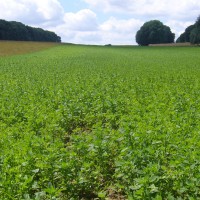Legumes fix atmospheric nitrogen

Legumes’ ability to fix atmospheric nitrogen (N2) with the help of symbiotic soil bacteria makes them unique. They also become especially interesting from a cultivation point of view and important for future sustainable agroecosystems. The use of legumes such as clover, lucern, pea, bean and soybean instead of N-fertilized crops can contribute to decrease the emissions of the greenhouse gases carbon dioxide (CO2) and nitrous oxide (N2O).
Growing legumes releases on average 60% less N2O than growing N-fertilized crops. Also CO2 emission and energy expenditure is less since the production of mineral N fertilizer is very energy demanding. 35-60% less fossil fuels are used to legumes and legume based pastures than to N-fertilized cereals and grasslands. This is mainly due to that there is no need for N-fertilization when growing legumes and the N requirement also becomes less in following crops in the crop sequence. Furthermore, the production of N fertilizer results in considerable emissions of CO2 and N2O.
Legumes also play a major role in contributing organic N, which is required to stimulate accumulation of carbon in the soil. Data from pastures and annual and perennial cultivation systems show that legumes do this at rates greater than the sequestration of carbon achieved by N-fertilized cereals or grasses.
Sara Muhonen, AgrD
